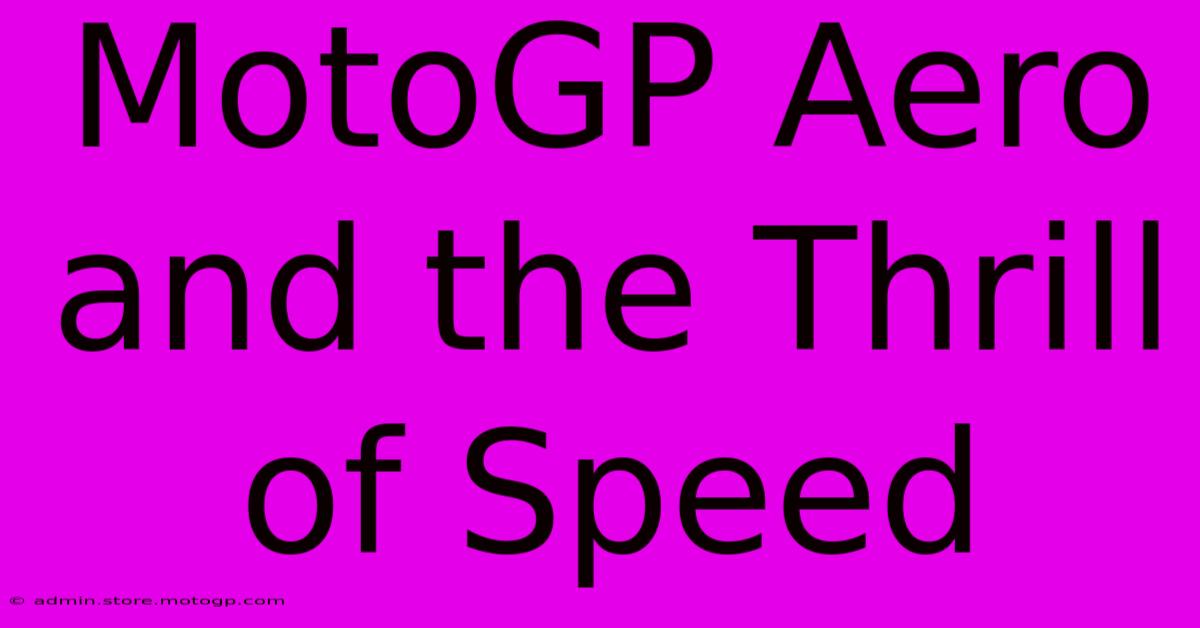MotoGP Aero And The Thrill Of Speed

Table of Contents
MotoGP Aero and the Thrill of Speed
The roar of the engines, the smell of burning rubber, the breathtaking speeds – MotoGP is a spectacle of adrenaline-fueled racing. But beyond the raw power and skill of the riders lies a crucial element that shapes the race: aerodynamics. MotoGP aero isn't just about speed; it's about control, stability, and ultimately, victory. Let's delve into the fascinating world of MotoGP aerodynamics and how it contributes to the thrill of the sport.
Understanding the Role of Aerodynamics in MotoGP
At speeds exceeding 200 mph, aerodynamics play a pivotal role in a MotoGP bike's performance. The intricate designs of fairings, wings, and spoilers aren't just for show; they are meticulously engineered to manage several key factors:
1. Downforce: The Grip Factor
Downforce is arguably the most crucial aspect of MotoGP aero. It's the force that pushes the bike down onto the track, increasing grip, particularly through corners. This increased grip allows riders to lean into turns at higher speeds and maintain control, preventing high-speed crashes. Without sufficient downforce, the bikes would become unstable and incredibly difficult to handle at such high speeds.
2. Drag Reduction: The Speed Game
While downforce is essential for grip, drag is the opposing force that resists the bike's forward motion. MotoGP engineers strive to find the optimal balance: enough downforce for cornering prowess but minimal drag to maximize top speed on straights. Sophisticated designs, including winglets and carefully shaped fairings, aim to reduce drag while maintaining the necessary downforce.
3. Stability and Control: The Winning Edge
Aerodynamic stability is crucial for rider safety and performance. The airflow around the bike needs to be managed effectively to prevent unpredictable movements, especially in turbulent conditions or during overtaking maneuvers. Innovative aerodynamic solutions contribute to a stable platform, empowering riders to push their limits with confidence.
The Evolution of MotoGP Aerodynamics
MotoGP aero has undergone a dramatic evolution over the years. From rudimentary fairings to the complex appendages seen today, the development reflects continuous innovation and a relentless pursuit of speed and control.
Early Days: Simple Fairings
Initially, fairings were primarily focused on protecting the rider and engine. Aerodynamic considerations were secondary.
The Rise of Winglets: A Game Changer
The introduction of winglets marked a significant turning point. These small, wing-like structures generate substantial downforce, improving stability and cornering speeds. Their effectiveness led to their rapid adoption by all teams.
Current Trends: Sophisticated Designs
Modern MotoGP bikes feature incredibly complex aerodynamic packages. These include:
- Larger, more sophisticated winglets: These are often strategically placed to maximize downforce while minimizing drag.
- Streamlined fairings: Optimized shapes and surface textures minimize drag and improve airflow.
- Underbody aerodynamics: Careful shaping of the underbody generates downforce and improves stability.
The Impact on Racing Strategy and Rider Skill
The advancements in MotoGP aero have profoundly impacted racing strategies. Teams must carefully consider the aerodynamic characteristics of their bikes when designing race strategies. The choice of aero package can significantly influence performance on specific tracks. Furthermore, riders need exceptional skill to harness the benefits of advanced aero while managing the increased forces acting upon the bike.
The Future of MotoGP Aerodynamics
The pursuit of aerodynamic perfection is an ongoing process. Expect continued advancements, with teams exploring even more innovative solutions. Computational Fluid Dynamics (CFD) simulations and wind tunnel testing play crucial roles in this continuous improvement. The future promises even more thrilling races with bikes that are faster, more stable, and even more technically advanced.
In Conclusion:
The thrill of MotoGP is undeniably linked to the incredible speeds achieved. But those speeds are not simply a result of raw engine power. The sophisticated world of MotoGP aerodynamics plays a critical role, providing the grip, stability, and control necessary for riders to push the boundaries of speed and precision. The ongoing evolution of aero technology guarantees that the sport will continue to be a captivating spectacle of engineering brilliance and human skill.

Thank you for visiting our website wich cover about MotoGP Aero And The Thrill Of Speed. We hope the information provided has been useful to you. Feel free to contact us if you have any questions or need further assistance. See you next time and dont miss to bookmark.
Featured Posts
-
Lot F Cota The Simple Solution For Desired Outcome
Feb 20, 2025
-
Moto Gp Arcade Buckle Up And Hold On
Feb 20, 2025
-
F1 Austin Tv Schedule Your Race Weekend Companion
Feb 20, 2025
-
F1 Austin A Symphony Of Speed And Sound
Feb 20, 2025
-
The Insiders Austin F1 Map Tips And Tricks For Navigating Cota
Feb 20, 2025
